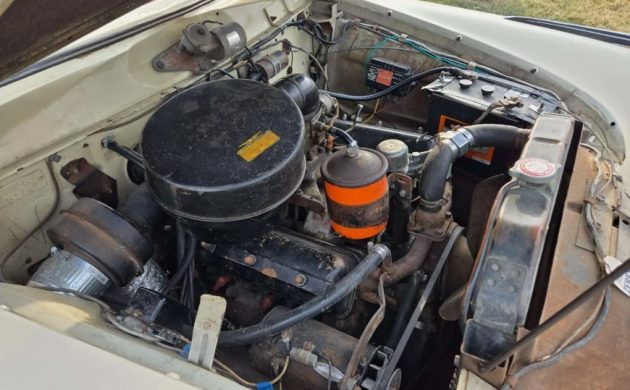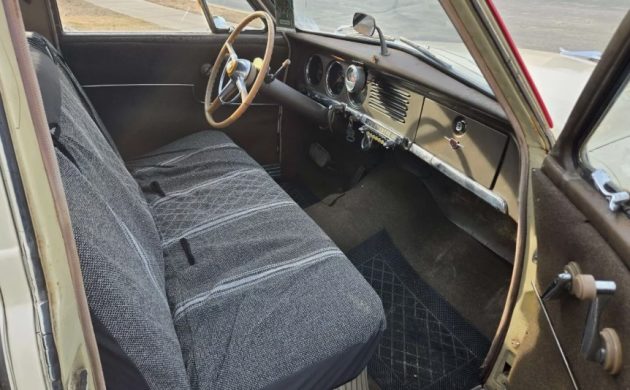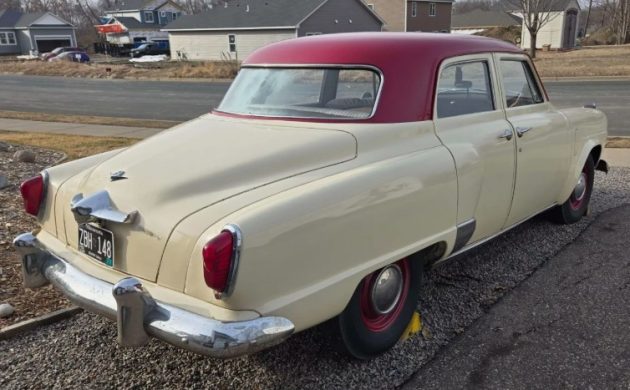How did the 1950-51 Commander acquire its beak? The styling was a pivot point in the Titanic struggle between Raymond Loewy and Virgil Exner – two large egos squeezed together into Studebaker’s design studio for several years. Assigned to renew the 1940s product line, they squabbled, maneuvered, and rebelled. Exner quit in a fit of pique, leaving Bob Bourke to execute Loewy’s instructions favoring the airplane elements so fashionable at the time. The controversial bullet nose lasted only two years, coinciding with Studebaker’s sales zenith: from then on out, it was downhill. Here on eBay is a 1951 Studebaker Commander sedan, bid to $4200, reserve not met. A buy-it-now price offers the opportunity to terminate the auction for $6000. The car is located in Montrose, Minnesota.
In an attempt to diminish the controversy surrounding the Commander’s snout, the company painted the outer ring of its ornament in ’51 to blend it into the hood – in ’50, the entire unit was chrome. But the big news was under the hood, not on it: this was the first year of Studebaker’s V8. Displacing 232 cu. in., the engine came out of the factory with a 7.0:1 compression ratio and 120 hp. It shifts via an automatic. Considerable work has been performed including replacing most of the brake parts, the shocks, and the fuel pump. The carburetor, starter, generator, and voltage regulator were rebuilt. The tires are also new (except the spare as we’ll see). Though this list is encouraging, the seller notes that the engine smokes on start up and may need a valve job – or more. It also needs a new exhaust – a new muffler is included.
The interior is worn but retains the vintage appliance quality carried over from the ’40s. The aftermarket seat cover probably hides poor upholstery; just about every corner shows a bit of wear – a tear here, a seam separating there. The trunk contains the spare – about as bald as I have ever seen – and a few parts. The seller notes that the speedometer just quit and the fuel gauge doesn’t always work, but everything else does. I appreciate that the seller tidied the car for its photo shoot – despite its flaws, it’s clean and well-presented.
The color combination is attractive even if the body has a few shallow dings and a rust spot or two. Speaking of rust, the worst of it is shown here, under the trunk: that’s the tread of the spare tire you’re seeing through that hole. This rare Commander will suffer in the market place as buyers abandon ’40s and ’50s cars, but the seller isn’t asking much for it anyway. What do you think this bullet-nose Studebaker is worth?







Every time I see a ’51 bullet nose I here “Dr. Teeth And Electric Mayhem” playing in the background…
Fozzy Bear Approved!!!!
Beautiful car, great face, v8, suicide doors. Very reasonable, no one else will have one.
A hit at Cars and coffee
A hit at Cars and coffee
I would look for one in better condition and prepare to pay a little more, but it would be worth it. For example, perhaps one owned by a Studebaker enthusiast who rebuilt the engine and took care of some of the annoying issues. The values of Studebakers except for a couple models are heading downward, as I learned when I sold mine.
I am really starting to get into early post-war cars (1946-52ish). As a man in his twenties who works in the humanities, I greatly appreciate their mostly reasonable prices. I imagine in the next five years that they will continue to decline in price or at least stay at their current affordability. However, the catch-22 is that there will be fewer people to enjoy them or help preform any work that I am unable to do.
Good for you! And not only are their prices reasonable, they’re also relatively stylish when compared to todays lookalikes. YouTube is your friend for work that needs to be done, just be sure to rustle up several videos to compare them. There’s a lot of misinformation out there.
You don’t realize how big these are until you see one in person. There is a lot of room in these and Stude was at the top of their game with these. That new V-8 was a big upgrade from the flathead six, and the bullet nose made other years look plain. Seeing the size of these, they must have been way under powered with the six. I don’t know if this will get a complete restoration, but at 5 grand I hope somebody will step up, fix it up and make a driver out of it. Maybe It will keep one of us old guys off the streets and out of trouble.
Can’t keep my yap shut on this one, it was such a neat design, military inspired all the way. Even the passenger area resembled an aircraft turret. Everyone, me included, think Caddy or Olds with a V8, but apparently, Studebaker was right in there. This car was no slouch, by 1951 standards. 0-60 in 13.9, and 1/4 mile just under 20, but this car could almost hit 100 mph. Not surprisingly was the car of choice for many police depts. including Gotham City in Batman.
Re: spare tire baldness? Good heavens, possibly dates the author, as that tire was perfect for a “regroove”, plenty of rubber left. I suspect that tire was on the right rear. Got a lot going for it, V8, retro styling, and of course, the automatic. This car wasn’t cheap. With V8 and automatic, this car was almost $2grand new, and while the 4 door was the most popular, only 21,000 were sold. Almost $500 more than a Ford, the V8 was the cheese here. Great find.
When you compare the styling of this Stude, to the 1951 Ford? You’ll understand why Ford sold 10× more.
My mother had a ’51 Ford that I learned to drive in high school. It was a great car performance wise. But its styling earned it the name of “pregnant roller skate.” Even so, I still prefer the Ford styling to the Studebaker for that year. Most American cars looked at least somewhat clunky until the styling explosion in 1955 when everything was suddenly beautiful and sleek with two-tone vibrant colors and super powerful quiet engines with a ride to match. Wow! What a year for the industry.
To the good, the fit and finish was better than a Ford, Chevy, and marginally a Plymouth, to the bad, the 6 and the V8 were oil burners, they all smoked early on into engine life – note my Toyota with 193,000 miles still burns no oil. The color combination might have been original, it or something close, was the combination on the ’53 Lowey couple where it looks really fine, this looks like a clown car to me. Grew up in the back seat of a ’50 4 door, same car but with the 6. New engine at 40,000 miles, no oil filter on the one from the factory. “Midnight Blue” paint which oxidized and was irridescent by ’56, something you do not see any more. Yes, buy this, and you will probably never see another, particularly in this color combo.
These cars were ubiquitous when I was a kid. To your point, I still associate them with a following cloud of blue oil smoke. That said, I think Charlie (below) is a bit unfair to compare, in any way, the car’s engine to the one in his high-mileage Toyota. Many cars from the post-war era–including Fords, which were held in high regard–tended to burn (and leak) oil. I don’t know of any brands that characteristically do so now. Automotive engineering and technology has come a long way in the three-quarters of a century since this old Studebaker was designed and built.
Bought new Chevy Traverse SUV in 2020. Around 40,000 miles I had to start adding oil. Service department then told me when I complained that GM states that engine using 2.5 qts in between oil changes is normal. Would never have bought that SUV if I had known that. Pay more and buy Japanese is lesson learned. My Toyota and Honda never burned or leaked oil. Restored a 1950 Hudson except for the engine. I had to add a qt of oil every 25 miles because the original waxed rope seal between the engine and transmission was worn out and that is where the oil leaked. To change that the engine needed to be pulled out. So just sold the car instead of rebuilding the engine.
I don’t know why but these cars have a certain appeal.
I preferred the look of the 1950, but the 1951 clearly was a much mechanically-improved automobile, over the 1950. The comments here on the engines in Studebakers, along with their propensity for rust (particularly around that cowl vent) helps to explain why these didn’t last very well on the roads, and why I should pass on the prospect of owning one. This seller got in over his head on needed work, and has decided to bail, rather than to fix the engine and other things, to make this car into a reliable driver. The price is low, but this car is no bargain.
If it was a 2dr, save it. Otherwise, let it be.
I like it— — — —Any car worth having always needs something. I have never seen 1 other than in pictures. Even If it’s not perfect it’s still going to draw a lot of attention. I could live without the red roof .
Well someone liked it enough to buy it. One thing about a Studebaker of this vintage is that you won’t mistake it for anything else. I agree with Michelle about that bald spare tire being exceptionally bald. But my dad had baldies on his 1958 Chevy that were showing their cords right before he junked it. His baldies were actually being driven. Not on display in the trunk.
I routinely drove my first few cars–back when the world’s best minds still considered the earth flat–on bald tires that frequently showed their cording. Indeed, if you looked hard enough at those tires, I swear you could see the air in them.
Times were different then. Parents smoked. There were no child seats, no seat restraints, no radios, no AC–hell, some of my earliest cars weren’t even equipped with heaters.
Sometimes I wonder how I survived my first two decades.
I met a guy locally, he was a “traveler” he said, no job right now, no money in the bank, an old Toyota pickup with a camper on it. Five decades ago he would have been a hobo, riding the rails, but the same as now, worked odd jobs, washed dishes in resturants, and then on his way. All four tires were completely bald. “I stay in the desert, dry roads, don’t need tread, if it rains, I just stay put.” So, if you live well, maybe treads are an unneeded extra. “I get the tires free, just pay to get them mounted”, since it costs the repair garages to get rid of them.
Beautiful car, not much rust Bullet Nose and suicide doors. I’m sure the new owner will enjoy the car.
If the ” Bullet ” nose was a Moving Headlight, it would resemble 48 Tucker, to some extent.
Rust bucket?? What are you seeing that I’m not.
Sold for $6000, so did not go to junk yard.
My sister has a 2019 Hyundai Tucson and my daughter a 2018 Hyundai Elantra. Both vehicles use oil. 65,000 miles on the Tucson and 120,000 miles on the Elantra. My daughter was told by a mechanic that the engine runs hot and to make sure to watch the coolant level besides the oil level.
The first car I remember my parents having was a green 1951 Studebaker. I was always embarrassed to ride in it, although I was only 5 or 6. We got t-boned by a 1949 Ford in 1957. Dad tried to fix it, but the frame was bent, so he went and bought a repo-ed 1956 Plymouth.
I found out years later that the Stude was a Starlight coupe. It had a six and overdrive.
Thanks Michelle for another well researched and written article.
Studebaker was one of the most well built cars of the period, next to Hudson.
The RoK military is still using the Stude duce and a half left overs from WW2.
Granted; the engines are rebuilt by Hyundai.
I was impressed to see loads of our old vehicles still in use, even the M4 tank, that thing is huge!